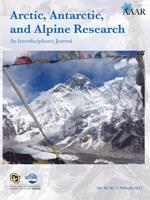This study uses a three-dimensional groundwater flow model to investigate groundwater dynamics and groundwater—surface water (GW-SW) interactions considering the effects of permafrost distribution for the Tanana Flats Basin in interior Alaska. The Parameter ESTimation (PEST) code is used to calibrate the model with observed stream discharge data. A 36-year MODLFOW-USG regional simulation shows the following. (1) Permafrost impedes groundwater movement in all directions and through taliks provides a major pathway to connect the groundwater and surface water systems. More than 80% of the vertical groundwater flow occurs within the permafrost-free zones. (2) Permafrost holds a significant amount of water that cannot be easily released through groundwater movements; however, water above the permafrost table has much higher renewal rates than deep groundwater. (3) Groundwater upwelling supports the base flow for the Tanana River and its tributaries throughout the year and feeds water to the wetland ecosystems at the Tanana Flats through unfrozen zones. Stream leakage is also highly correlated with stream discharge. Our study suggests that cold regional hydrological cycle studies should consider the effects of permafrost distribution under future warming conditions. This study provides a robust three-dimensional hydrological modeling tool that can be applied for the regions underlain with either continuous or discontinuous permafrost.
How to translate text using browser tools
1 February 2017
Quantifying the Role of Permafrost Distribution in Groundwater and Surface Water Interactions Using a Three-Dimensional Hydrological Model
Chang Liao,
Qianlai Zhuang





